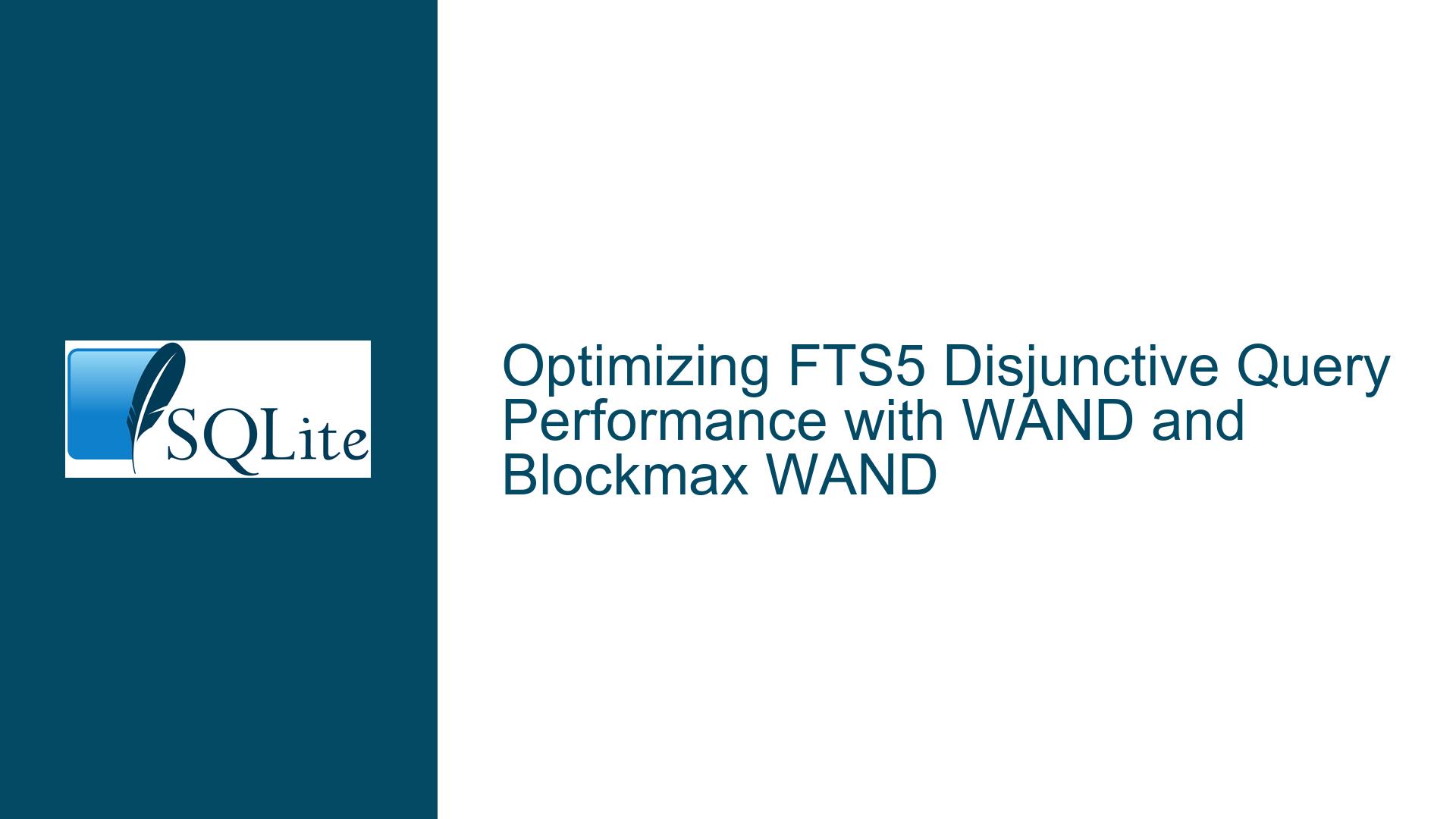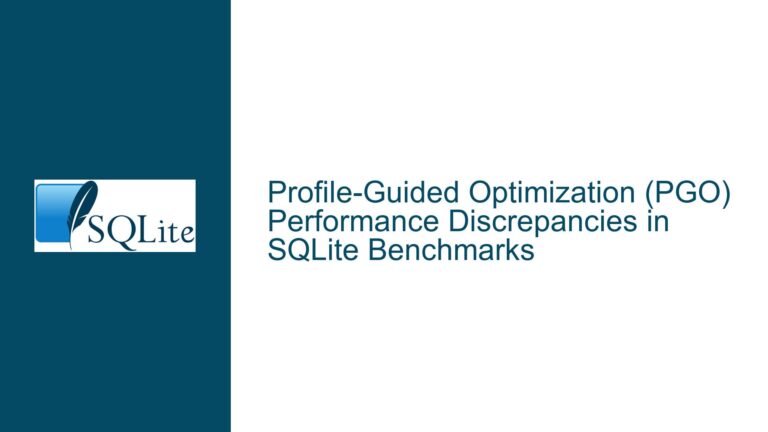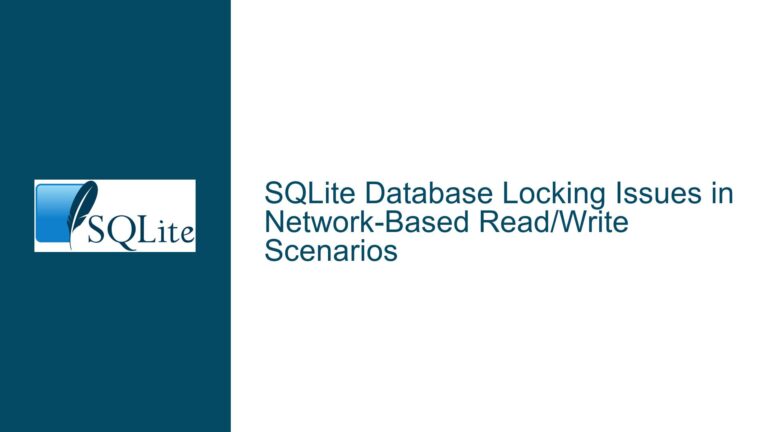Optimizing FTS5 Disjunctive Query Performance with WAND and Blockmax WAND
Understanding FTS5 Disjunctive Query Performance Degradation
When working with SQLite’s FTS5 extension, one of the most common performance bottlenecks arises when executing disjunctive queries, particularly those involving the OR operator. As the number of terms in the query increases, the search performance tends to degrade significantly. This degradation is primarily due to the way FTS5 handles disjunctive queries, which involves scanning and scoring a large number of documents, even those that may not be relevant to the final result set. The problem is exacerbated when the dataset is large, as the computational overhead increases linearly with the number of terms and documents.
The core issue lies in the fact that FTS5, in its current implementation, does not employ advanced optimization techniques like the Weak AND (WAND) operator or its more efficient variant, Blockmax WAND. These techniques are designed to reduce the number of documents that need to be fully scored by quickly eliminating those that are unlikely to be in the top results. Without such optimizations, FTS5 must evaluate every document that matches any of the terms in the disjunctive query, leading to inefficiencies.
The WAND operator, first introduced by Andrei Broder in 2003, addresses this problem by using a two-level retrieval process. The first level involves a quick pre-selection of documents that are likely to be relevant, based on a threshold score. The second level then performs a more detailed scoring of these pre-selected documents. This approach significantly reduces the number of documents that need to be fully evaluated, thereby improving query performance.
Blockmax WAND, an improvement over the original WAND algorithm, further optimizes this process by dividing the index into blocks and applying the WAND algorithm within each block. This allows for even faster elimination of irrelevant documents, as the algorithm can skip entire blocks of documents that do not meet the threshold score. The LazyBM algorithm, introduced in 2020, builds on these concepts by introducing lazy evaluation, which further reduces the computational overhead by deferring the scoring of documents until absolutely necessary.
Given the proven effectiveness of these techniques in other search engines like Elasticsearch, it is natural to question whether FTS5 implements any form of MAXSCORE or WAND optimization. As of the current version, FTS5 does not include these optimizations, which is a significant limitation when dealing with large datasets and complex disjunctive queries.
Exploring the Absence of WAND and Blockmax WAND in FTS5
The absence of WAND and Blockmax WAND optimizations in FTS5 can be attributed to several factors. First, SQLite is designed to be a lightweight, embedded database engine, and its FTS5 extension is optimized for simplicity and ease of use rather than high-performance search capabilities. This design philosophy means that some advanced features, like WAND and Blockmax WAND, may not be prioritized in the development roadmap.
Second, implementing these optimizations would require significant changes to the FTS5 indexing and query evaluation mechanisms. The current FTS5 architecture is based on inverted indexes, which are efficient for simple queries but less so for complex disjunctive queries. Introducing WAND or Blockmax WAND would necessitate a more sophisticated indexing strategy, potentially involving additional data structures and algorithms to support the two-level retrieval process.
Another factor is the trade-off between complexity and performance. While WAND and Blockmax WAND can significantly improve query performance, they also introduce additional complexity to the query evaluation process. This complexity could make FTS5 less predictable and harder to debug, which may not align with SQLite’s goal of being a straightforward and reliable database engine.
Furthermore, the development of FTS5 is driven by the needs of its user base, which may not always prioritize advanced search optimizations. Many users of SQLite are looking for a simple, embedded solution that can handle basic full-text search requirements without the need for complex configurations or additional dependencies. As a result, the demand for features like WAND and Blockmax WAND may not be high enough to justify their implementation.
However, the absence of these optimizations does not mean that FTS5 is incapable of handling disjunctive queries. There are several strategies that can be employed to mitigate the performance degradation, such as query rewriting, index optimization, and leveraging external tools or extensions. These strategies can help improve the performance of disjunctive queries in FTS5, even without the advanced optimizations provided by WAND and Blockmax WAND.
Strategies for Improving FTS5 Disjunctive Query Performance
While FTS5 does not natively support WAND or Blockmax WAND optimizations, there are several strategies that can be employed to improve the performance of disjunctive queries. These strategies involve a combination of query optimization, index tuning, and leveraging external tools or extensions.
One effective strategy is query rewriting, which involves transforming the original disjunctive query into a more efficient form. For example, instead of using a large number of OR conditions, the query can be rewritten to use a combination of AND and OR conditions, or to use more specific terms that reduce the number of documents that need to be evaluated. This approach can help reduce the computational overhead by narrowing down the search space.
Another strategy is to optimize the FTS5 index by adjusting the tokenizer and indexing options. The tokenizer determines how the text is split into terms, and choosing the right tokenizer can have a significant impact on query performance. For example, using a tokenizer that supports stemming or stop words can help reduce the number of terms that need to be indexed and searched. Additionally, adjusting the indexing options, such as the prefix and suffix lengths, can help improve the efficiency of the index.
Leveraging external tools or extensions is another approach to improving FTS5 query performance. For example, using a dedicated search engine like Elasticsearch or Apache Lucene in conjunction with SQLite can provide the advanced search optimizations that FTS5 lacks. These tools can handle the complex disjunctive queries more efficiently, while SQLite can be used for storing and managing the data. This hybrid approach allows for the best of both worlds, combining the simplicity and reliability of SQLite with the advanced search capabilities of a dedicated search engine.
In addition to these strategies, it is also important to consider the hardware and environment in which SQLite is running. Optimizing the hardware, such as using faster storage or more memory, can help improve the overall performance of FTS5 queries. Similarly, tuning the SQLite configuration settings, such as the cache size and page size, can help improve query performance.
Finally, it is worth noting that the SQLite development team is continuously working on improving the performance and features of FTS5. While WAND and Blockmax WAND optimizations may not be available in the current version, future updates may include these or other advanced search optimizations. Keeping an eye on the SQLite release notes and participating in the SQLite community can help stay informed about the latest developments and best practices for optimizing FTS5 queries.
In conclusion, while FTS5 does not currently support WAND or Blockmax WAND optimizations, there are several strategies that can be employed to improve the performance of disjunctive queries. By optimizing the query, tuning the index, leveraging external tools, and considering the hardware and environment, it is possible to achieve significant performance improvements. Additionally, staying informed about the latest developments in SQLite and FTS5 can help ensure that you are using the most effective techniques for optimizing your queries.






